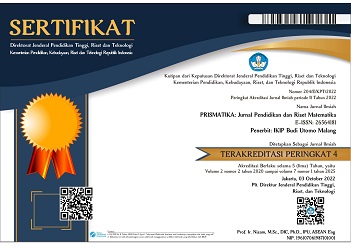EKSPLORASI IDE-IDE MATEMATIKA PADA KESENIAN REYOG TULUNGAGUNG
Abstract
Mathematical learning is abstract. A learning innovation is needed by considering aspects of daily life so abstract mathematical concepts can be understood by students. Mathematics and culture are two interrelated things, the bridge between the two is called ethnomatematics. The focus of the research is on the 6 main elements of Reyog Tulungagung. This research is a qualitative research with ethnographic approach. The results of research in the form of mathematical ideas which are found based on the physical form of Reyog Tulungagung art elements, including: (1) mathematical ideas in gong, namely circles, arcing curved spaces, volumes of rotating objects, and symmetry; (2) mathematical ideas on the selompret, namely construct curved side spaces, rotating objects volume, and symmetry; (3) mathematical ideas on kenong namely circles, build curved side spaces, and rotary object volumes; (4) mathematical ideas on iker namely lines, circumference of circles, and symmetry; (5) mathematical ideas on dhodhog, that are circles, arcing curves, volume of rotating objects, triangles, and one-to-one correspondence; (6) mathematical ideas on goseng namely counting and arithmetic (addition and multiplication). In addition there is also a mathematical idea of how to play musical instruments, namely repetitive patterns.
References
Mathematics. University of Auckland, Auckland.
Bazinet, R., & Marshall, A. M. (2015). Ethnomusicology, Ethnomathematics,
and Integrating Curriculum. General Music Today, 28(3), 5–11.
Charitas, R., & Prahmana, I. (2018). Ethnomathematics: exploring the
activities of designing kebaya kartini. MaPan : Jurnal Matematika Dan
Pembelajaran, 6(1), 10–19.
Damayanti, P. R., Agung, A., & Cahyadi, J. (2018). Perancangan Media
Pendukung Tentang Sejarah Reyog Kendang Tradisi Khas Tulungagung
Dalam Video Animasi. Jurnal DKV Adiwarna, 1(12), 1–10.
Ekowati, D. W., Kusumaningtyas, D. I., & Sulistyani, N. (2017).
Ethnomathematica Dalam Pembelajaran Matematika (Pembelajaran
Diesty Hayuhantika, Dwi Shinta Rahayu
Eksplorasi Ide-ide Matematika pada Kesenian Reyog Tulungagung
Prismatika: Jurnal Pendidikan dan Riset Matematika Vol. 2 No. 1 (2019) 14
Bilangan Dengan Media Batik Madura , Tari Khas Trenggal Dan Tari Khas
Madura). Jurnal Pemikiran Dan Pengembangan SD, 5(2), 716–721.
Febriyanti, C., Prasetya, R., & Irawan, A. (2018). Etnomatematika Pada
Permainan Tradisional Engklek dan Gasing Khas Kebudayaan Sunda.
Barekeng: Jurnal Ilmu Matematika Dan Terapan, 12(1), 1–6.
Irfan, M. N. (2017). Perkembangan Kesenian Reyog Tulungagung. AVATARA,
5(3), 1112–1122.
Küçük, A. (2014). Ethnomathematics in Anatolia-Turkey : Mathematical
Thoughts in Multiculturalism. Revista Latinoamericana de
Etnomatemática, 7(1), 171–184.
Rachmawati, I. (2012). Eksplorasi Etnomatematika Masyarakat Sidoarjo.
MATHEdunesa, 1(1), 1–8.
Sarwoedi, Marinka, D. O., Febriani, P., & Wirne, I. N. (2018). Efektifitas
Etnomatematika dalam Meningkatkan Kemampuan Pemahaman
Matematika Siswa Pendahuluan. Jurnal Pendidikan Matematika Raflesia,
03(02), 171–176.
Shanti, U. A. (2017). Kesenian Reog Kendang Tulungagung sebagai Inspirasi
Pengembangan Motif Batik di Kabupaten Tulungagung. Prosiding.
Seminar Nasional Seni dan Desain: “Membangun Tradisi Inovasi Melalui
Riset Berbasis Praktik Seni dan Desain” FBS Unesa : 196–202.
Wahyuni, I. (2016). Eksplorasi Etnomatematika Masyarakat Pesisir Selatan
Kecamatan Puger Kabupaten Jember. Fenomena, 15(2), 225–238.







.png)




